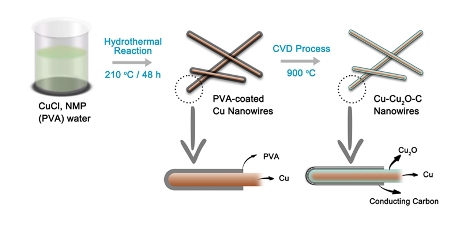A research team from Rice University has fabricated a coaxial cable 100 nm wide, which demonstrates better capacitance than previously reported microcapacitors.
 The three-layer coaxial nanocable contains a solid copper wire surrounded by a layer of copper oxide that is encased a layer of carbon just a few atoms thick.
The three-layer coaxial nanocable contains a solid copper wire surrounded by a layer of copper oxide that is encased a layer of carbon just a few atoms thick.
The research has been reported in the journal Nature Communications. The researchers used technologies used in the emerging graphene research field to produce this nanocable, which has potential application in the development of advanced energy-storage systems and as wiring-up components for lab-on-a-chip processors.
Jun Lou, co-author of the study, says that the researchers originally aimed to explore electrical and mechanical effects of tiny copper wires called as interconnects when they were coated with a thin carbon layer.
The core part of the nanocable is a solid copper wire which is covered by a thin insulating copper oxide layer. The outermost layer is a few-atom-thick carbon layer.
Besides showing promise in broadband telecommunications, the coaxial cable may find use in the development of energy-storage devices such as capacitors. The study reported that the three-layer, metal-insulator-metal structure has a capacitance an order of magnitude greater than that of typical electrostatics. Pulickel Ajayan, co-author of the study, explained that this increase is mainly because of quantum effects caused by the cable’s tiny size.
During the study, Zheng Liu, a Rice University postdoctoral researcher and the study’s lead author, planned to fabricate pure copper wires coated with carbon. Liu used chemical vapor deposition (CVD) to deposit carbon as a thin layer over the copper wires. Lou commented that copper films have been used as a platform to grow graphene using the CVD technique.
From electronic tests on samples produced, the researchers discovered the formation of a thin dielectric copper oxide layer between the carbon and the copper, said Liu. Other researchers had reported the occurrence of oxidation on the copper substrates in the production of graphene. However, nobody conducted a detailed study on the electronic properties of such intricate interfaces, stated Ajayan.
Lou stated that a large-scale energy-storage device may be possible by aligning millions of these nanocables alongside in large arrays. Liu commented that this nanocable shows promise in radio frequency signal transmission at the nanoscale, hence can be utilized as a basic building block in nano- or micro-sized electromechanical systems such as lab-on-a-chip devices.